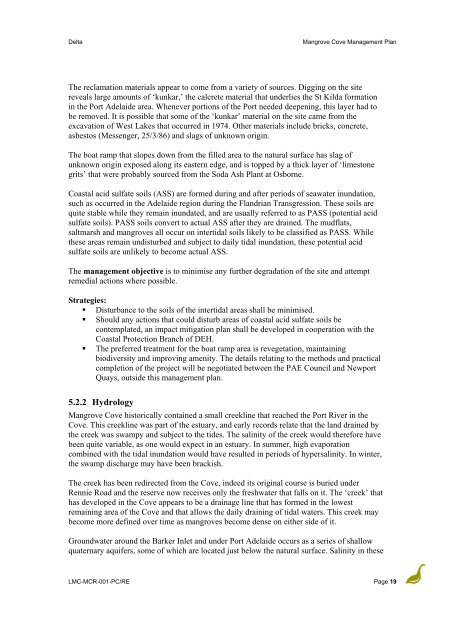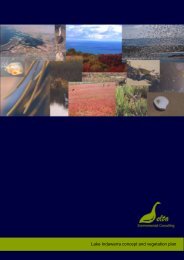Mangrove Cove
Environmental Management Plan for Mangrove Cove - Delta ...
Environmental Management Plan for Mangrove Cove - Delta ...
- No tags were found...
Create successful ePaper yourself
Turn your PDF publications into a flip-book with our unique Google optimized e-Paper software.
Delta<br />
<strong>Mangrove</strong> <strong>Cove</strong> Management Plan<br />
The reclamation materials appear to come from a variety of sources. Digging on the site<br />
reveals large amounts of ‘kunkar,’ the calcrete material that underlies the St Kilda formation<br />
in the Port Adelaide area. Whenever portions of the Port needed deepening, this layer had to<br />
be removed. It is possible that some of the ‘kunkar’ material on the site came from the<br />
excavation of West Lakes that occurred in 1974. Other materials include bricks, concrete,<br />
asbestos (Messenger, 25/3/86) and slags of unknown origin.<br />
The boat ramp that slopes down from the filled area to the natural surface has slag of<br />
unknown origin exposed along its eastern edge, and is topped by a thick layer of ‘limestone<br />
grits’ that were probably sourced from the Soda Ash Plant at Osborne.<br />
Coastal acid sulfate soils (ASS) are formed during and after periods of seawater inundation,<br />
such as occurred in the Adelaide region during the Flandrian Transgression. These soils are<br />
quite stable while they remain inundated, and are usually referred to as PASS (potential acid<br />
sulfate soils). PASS soils convert to actual ASS after they are drained. The mudflats,<br />
saltmarsh and mangroves all occur on intertidal soils likely to be classified as PASS. While<br />
these areas remain undisturbed and subject to daily tidal inundation, these potential acid<br />
sulfate soils are unlikely to become actual ASS.<br />
The management objective is to minimise any further degradation of the site and attempt<br />
remedial actions where possible.<br />
Strategies:<br />
• Disturbance to the soils of the intertidal areas shall be minimised.<br />
• Should any actions that could disturb areas of coastal acid sulfate soils be<br />
contemplated, an impact mitigation plan shall be developed in cooperation with the<br />
Coastal Protection Branch of DEH.<br />
• The preferred treatment for the boat ramp area is revegetation, maintaining<br />
biodiversity and improving amenity. The details relating to the methods and practical<br />
completion of the project will be negotiated between the PAE Council and Newport<br />
Quays, outside this management plan.<br />
5.2.2 Hydrology<br />
<strong>Mangrove</strong> <strong>Cove</strong> historically contained a small creekline that reached the Port River in the<br />
<strong>Cove</strong>. This creekline was part of the estuary, and early records relate that the land drained by<br />
the creek was swampy and subject to the tides. The salinity of the creek would therefore have<br />
been quite variable, as one would expect in an estuary. In summer, high evaporation<br />
combined with the tidal inundation would have resulted in periods of hypersalinity. In winter,<br />
the swamp discharge may have been brackish.<br />
The creek has been redirected from the <strong>Cove</strong>, indeed its original course is buried under<br />
Rennie Road and the reserve now receives only the freshwater that falls on it. The ‘creek’ that<br />
has developed in the <strong>Cove</strong> appears to be a drainage line that has formed in the lowest<br />
remaining area of the <strong>Cove</strong> and that allows the daily draining of tidal waters. This creek may<br />
become more defined over time as mangroves become dense on either side of it.<br />
Groundwater around the Barker Inlet and under Port Adelaide occurs as a series of shallow<br />
quaternary aquifers, some of which are located just below the natural surface. Salinity in these<br />
LMC-MCR-001-PC/RE Page 19



